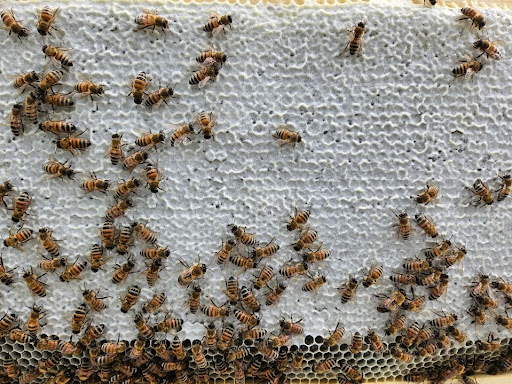Prepare to be grossed out. You're eating bee puke.

Here is a frame of capped honey ready to be extracted and enjoyed!
Have you ever wondered how flower nectar ends up as honey in jars? Let's take a peek inside the fascinating world of honey making! The journey of honey begins with a bee's visit to a flower. Bees are attracted to the flower's nectar, a sugary liquid produced to attract pollinators. Using their long tongues, called a proboscis, bees slurp up the nectar and store it in a special sac called the honey stomach. Here's the cool part: inside the honey stomach, special enzymes get to work! These enzymes break down complex sugars in the nectar into simpler ones, making the honey more readily available for bee consumption and easier to store.
Once a bee's honey stomach is full, it returns to the hive. There, the bee regurgitates the nectar and shares it with other worker bees. These bees further process the nectar by passing it back and forth between each other, concentrating the sugars through enzymatic activity which reduces the amount of water in the nectar. This thickened nectar continues to lose water until it is composed of less than 18.6% water, at which point it is called honey!
Finally, the bees deposit the honey into honeycomb cells, which they meticulously construct from beeswax. To prevent spoilage and preserve the honey, the bees seal the honeycomb cells with a wax cap. The constant fanning of their wings helps remove excess moisture from the nectar, further concentrating it into the honey we know and love.
When it is time to harvest, excess frames of honey are carefully removed from the hives. The honey is extracted from the wax comb by spinning the frames in a honey extractor which does not damage the wax and frames, so they can be reused by our bees. Soon after, the frames are then returned to the hives to start the process again. The collected honey is then bottled and stored for your use! The unique taste and color of honey depends on the types of flowers the bees visit. Our bees visit a collection of wildflowers which are local to the Macon area. This floral variety is what makes our honey’s taste unique in comparison to the commercial options you can buy in the store!
So next time you drizzle honey on your toast or stir it into your tea, take a moment to appreciate the incredible teamwork and biological processes that go into making this delicious and healthy treat.
